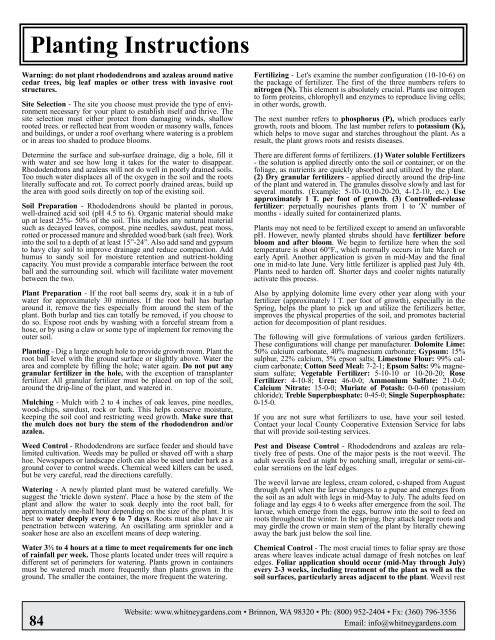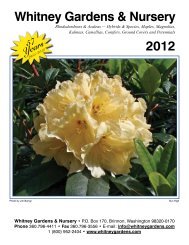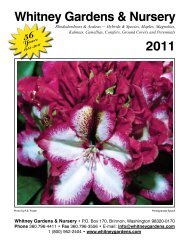Download the Catalog! - Whitney Gardens & Nursery
Download the Catalog! - Whitney Gardens & Nursery
Download the Catalog! - Whitney Gardens & Nursery
You also want an ePaper? Increase the reach of your titles
YUMPU automatically turns print PDFs into web optimized ePapers that Google loves.
Planting Instructions<br />
Warning: do not plant rhododendrons and azaleas around native<br />
cedar trees, big leaf maples or o<strong>the</strong>r tress with invasive root<br />
structures.<br />
Site Selection - The site you choose must provide <strong>the</strong> type of environment<br />
necessary for your plant to establish itself and thrive. The<br />
site selection must ei<strong>the</strong>r protect from damaging winds, shallow<br />
rooted trees. or reflected heat from wooden or masonry walls, fences<br />
and buildings, or under a roof overhang where watering is a problem<br />
or in areas too shaded to produce blooms.<br />
Determine <strong>the</strong> surface and sub-surface drainage, dig a hole, fill it<br />
with water and see how long it takes for <strong>the</strong> water to disappear.<br />
Rhododendrons and azaleas will not do well in poorly drained soils.<br />
Too much water displaces all of <strong>the</strong> oxygen in <strong>the</strong> soil and <strong>the</strong> roots<br />
literally suffocate and rot. To correct poorly drained areas, build up<br />
<strong>the</strong> area with good soils directly on top of <strong>the</strong> existing soil.<br />
Soil Preparation - Rhododendrons should be planted in porous,<br />
well-drained acid soil (pH 4.5 to 6). Organic material should make<br />
up at least 25%- 50% of <strong>the</strong> soil. This includes any natural material<br />
such as decayed leaves, compost, pine needles, sawdust, peat moss,<br />
rotted or processed manure and shredded wood/bark (salt free). Work<br />
into <strong>the</strong> soil to a depth of at least 15”-24”. Also add sand and gypsum<br />
to havy clay soil to improve drainage and reduce compaction. Add<br />
humus to sandy soil for moisture retention and nutrient-holding<br />
capacity. You must provide a comparable interface between <strong>the</strong> root<br />
ball and <strong>the</strong> surrounding soil. which will facilitate water movement<br />
between <strong>the</strong> two.<br />
Plant Preparation - If <strong>the</strong> root ball seems dry, soak it in a tub of<br />
water for approximately 30 minutes. If <strong>the</strong> root ball has burlap<br />
around it, remove <strong>the</strong> ties especially from around <strong>the</strong> stem of <strong>the</strong><br />
plant. Both burlap and ties can totally be removed, if you choose to<br />
do so. Expose root ends by washing with a forceful stream from a<br />
hose, or by using a claw or some type of implement for removing <strong>the</strong><br />
outer soil.<br />
Planting - Dig a large enough hole to provide growth room. Plant <strong>the</strong><br />
root ball level with <strong>the</strong> ground surface or slightly above. Water <strong>the</strong><br />
area and complete by filling <strong>the</strong> hole; water again. Do not put any<br />
granular fertilizer in <strong>the</strong> hole, with <strong>the</strong> exception of transplanter<br />
fertilizer. All granular fertilizer must be placed on top of <strong>the</strong> soil,<br />
around <strong>the</strong> drip-line of <strong>the</strong> plant, and watered in.<br />
Mulching - Mulch with 2 to 4 inches of oak leaves, pine needles,<br />
wood-chips, sawdust, rock or bark. This helps conserve moisture,<br />
keeping <strong>the</strong> soil cool and restricting weed growth. Make sure that<br />
<strong>the</strong> mulch does not bury <strong>the</strong> stem of <strong>the</strong> rhododendron and/or<br />
azalea.<br />
Weed Control - Rhododendrons are surface feeder and should have<br />
limited cultivation. Weeds may be pulled or shaved off with a sharp<br />
hoe. Newspapers or landscape cloth can also be used under bark as a<br />
ground cover to control weeds. Chemical weed killers can be used,<br />
but be very careful, read <strong>the</strong> directions carefully.<br />
Watering - A newly planted plant must be watered carefully. We<br />
suggest <strong>the</strong> 'trickle down system'. Place a hose by <strong>the</strong> stem of <strong>the</strong><br />
plant and allow <strong>the</strong> water to soak deeply into <strong>the</strong> root ball, for<br />
approximately one-half hour depending on <strong>the</strong> size of <strong>the</strong> plant. It is<br />
best to water deeply every 6 to 7 days. Roots must also have air<br />
penetration between watering. An oscillating arm sprinkler and a<br />
soaker hose are also an excellent means of deep watering.<br />
Water 3½ to 4 hours at a time to meet requirements for one inch<br />
of rainfall per week. Those plants located under trees will require a<br />
different set of perimeters for watering. Plants grown in containers<br />
must be watered much more frequently than plants grown in <strong>the</strong><br />
ground. The smaller <strong>the</strong> container, <strong>the</strong> more frequent <strong>the</strong> watering.<br />
Fertilizing - Let's examine <strong>the</strong> number configuration (10-10-6) on<br />
<strong>the</strong> package of fertilizer. The first of <strong>the</strong> three numbers refers to<br />
nitrogen (N). This element is absolutely crucial. Plants use nitrogen<br />
to form proteins, chlorophyll and enzymes to reproduce living cells;<br />
in o<strong>the</strong>r words, growth.<br />
The next number refers to phosphorus (P), which produces early<br />
growth, roots and bloom. The last number refers to potassium (K),<br />
which helps to move sugar and starches throughout <strong>the</strong> plant. As a<br />
result, <strong>the</strong> plant grows roots and resists diseases.<br />
There are different forms of fertilizers. (1) Water soluble Fertilizers<br />
- <strong>the</strong> solution is applied directly onto <strong>the</strong> soil or container, or on <strong>the</strong><br />
foliage, as nutrients are quickly absorbed and utilized by <strong>the</strong> plant.<br />
(2) Dry granular fertilizers - applied directly around <strong>the</strong> drip-line<br />
of <strong>the</strong> plant and watered in. The granules dissolve slowly and last for<br />
several months. (Example: 5-10-10,10-20-20, 4-12-10, etc.) Use<br />
approximately 1 T. per foot of growth. (3) Controlled-release<br />
fertilizer: perpetually nourishes plants from 1 to 'X' number of<br />
months - ideally suited for containerized plants.<br />
Plants may not need to be fertilized except to amend an unfavorable<br />
pH. However, newly planted shrubs should have fertilizer before<br />
bloom and after bloom. We begin to fertilize here when <strong>the</strong> soil<br />
temperature is about 60°F., which normally occurs in late March or<br />
early April. Ano<strong>the</strong>r application is given in mid-May and <strong>the</strong> final<br />
one in mid-to late June. Very little fertilizer is applied past July 4th.<br />
Plants need to harden off. Shorter days and cooler nights naturally<br />
activate this process.<br />
Also by applying dolomite lime every o<strong>the</strong>r year along with your<br />
fertilizer (approximately l T. per foot of growth), especially in <strong>the</strong><br />
Spring, helps <strong>the</strong> plant to pick up and utilize <strong>the</strong> fertilizers better,<br />
improves <strong>the</strong> physical properties of <strong>the</strong> soil, and promotes bacterial<br />
action for decomposition of plant residues.<br />
The following will give formulations of various garden fertilizers.<br />
These configurations will change per manufacturer. Dolomite Lime:<br />
50% calcium carbonate, 40% magnesium carbonate; Gypsum: 15%<br />
sulphur, 22% calcium, 5% epson salts; Limestone Flour: 99% calcium<br />
carbonate; Cotton Seed Meal: 7-2-1; Epsom Salts: 9% magnesium<br />
sulfate; Vegetable Fertilizer: 5-10-10 or 10-20-20; Rose<br />
Fertilizer: 4-10-8; Urea: 46-0-0; Ammonium Sulfate: 21-0-0;<br />
Calcium Nitrate: 15-0-0; Muriate of Potash: 0-0-60 (potassium<br />
chloride); Treble Superphosphate: 0-45-0; Single Superphosphate:<br />
0-15-0.<br />
If you are not sure what fertilizers to use, have your soil tested.<br />
Contact your local County Cooperative Extension Service for labs<br />
that will provide soil-testing services.<br />
Pest and Disease Control - Rhododendrons and azaleas are relatively<br />
free of pests. One of <strong>the</strong> major pests is <strong>the</strong> root weevil. The<br />
adult weevils feed at night by notching small, irregular or semi-circular<br />
serrations on <strong>the</strong> leaf edges.<br />
The weevil larvae are legless, cream colored, c-shaped from August<br />
through April when <strong>the</strong> larvae changes to a pupae and emerges from<br />
<strong>the</strong> soil as an adult with legs in mid-May to July. The adults feed on<br />
foliage and lay eggs 4 to 6 weeks after emergence from <strong>the</strong> soil. The<br />
larvae, which emerge from <strong>the</strong> eggs, burrow into <strong>the</strong> soil to feed on<br />
roots throughout <strong>the</strong> winter. In <strong>the</strong> spring, <strong>the</strong>y attack larger roots and<br />
may girdle <strong>the</strong> crown or main stem of <strong>the</strong> plant by literally chewing<br />
away <strong>the</strong> bark just below <strong>the</strong> soil line.<br />
Chemical Control - The most crucial times to foliar spray are those<br />
areas where leaves indicate actual damage of fresh notches on leaf<br />
edges. Foliar application should occur (mid-May through July)<br />
every 2-3 weeks, including treatment of <strong>the</strong> plant as well as <strong>the</strong><br />
soil surfaces, particularly areas adjacent to <strong>the</strong> plant. Weevil rest<br />
Website: www.whitneygardens.com • Brinnon, WA 98320 • Ph: (800) 952-2404 • Fx: (360) 796-3556<br />
84 Email: info@whitneygardens.com





